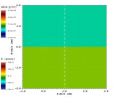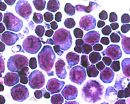(Press-News.org) Around a quarter of smokers who carry a defect in the BRCA2 gene will develop lung cancer at some point in their lifetime, a large-scale, international study reveals.
Scientists announce a previously unknown link between lung cancer and a particular BRCA2 defect, occurring in around 2 per cent of the population, in research published in Nature Genetics today (Sunday).
The defect in BRCA2 - best known for its role in breast cancer - increases the risk of developing lung cancer by about 1.8 times.
Smokers as a group have a high lifetime risk of around 13 per cent (16 per cent in men and 9.5 per cent in women). The new study therefore suggests around one in four smokers with the BRCA2 defect will develop lung cancer.
Around 10 million adults in Great Britain smoke, which means that up to around 200,000 adult smokers could have the specific BRCA2 defect, known as BRCA2 c.9976T.
The researchers, led by a team at The Institute of Cancer Research, London, compared the DNA of 11,348 Europeans with lung cancer and 15,861 without the disease, looking for differences at specific points in their DNA. The team was mainly funded by the US National Institute of Health, with additional support from Cancer Research UK.
The link between lung cancer and defective BRCA2 – known to increase the risk of breast, ovarian and other cancers – was particularly strong in patients with the most common lung cancer sub-type, called squamous cell lung cancer. The researchers also found an association between squamous cell lung cancer and a defect in a second gene, CHEK2, which normally prevents cells from dividing when they have suffered damage to their DNA.
The results suggest that in the future, patients with squamous cell lung cancer could benefit from drugs specifically designed to be effective in cancers with BRCA mutations. A family of drugs called PARP inhibitors have shown success in clinical trials in breast and ovarian cancer patients with BRCA mutations, although it is not known whether they could be effective in lung cancer.
Study leader Professor Richard Houlston, Professor of Molecular and Population Genetics at The Institute of Cancer Research (ICR), said: "Our study showed that mutations to two genes, BRCA2 and CHEK2, have a very large effect on lung cancer risk in the context of smoking. Mutated BRCA2 in particular seems to increase risk by around 1.8 times.
"Smokers in general have nearly a 15 per cent chance of developing lung cancer, far higher than in non-smokers. Our results show that some smokers with BRCA2 mutations are at an enormous risk of lung cancer – somewhere in the region of 25 per cent over their lifetime.
"Lung cancer claims more than a million lives a year worldwide and is by far the biggest cancer killer in the UK. We know that the single biggest thing we can do to reduce death rates is to persuade people not to smoke, and our new findings make plain that this is even more critical in people with an underlying genetic risk."
Professor Paul Workman, Deputy Chief Executive of The Institute of Cancer Research, said:
"These findings indicate that around a quarter of smokers with a specific defect in their BRCA2 gene will develop lung cancer – a disease which is almost invariably fatal. All smokers are taking a considerable risk with their health, regardless of their genetic profile, but the odds are stacked even more heavily against those with this genetic defect who smoke."
INFORMATION:
Smokers with gene defect have 1 in 4 chance of developing lung cancer
2014-06-01
ELSE PRESS RELEASES FROM THIS DATE:
Shining a light on memory
2014-06-01
Using a flash of light, scientists have inactivated and then reactivated a memory in genetically engineered rats. The study, supported by the National Institutes of Health, is the first cause-and-effect evidence that strengthened connections between neurons are the stuff of memory.
"Our results add to mounting evidence that the brain represents a memory by forming assemblies of neurons with strengthened connections, or synapses, explained Roberto Malinow, M.D., Ph.D., of the University of California, San Diego (UCSD), a grantee of the NIH's National Institute of Mental ...
Study identifies new genetic cause of male reproductive birth defects
2014-06-01
HOUSTON – (June 1, 2014) – Baylor College of Medicine scientists defined a previously unrecognized genetic cause for two types of birth defects found in newborn boys, described in a report published today in the journal Nature Medicine.
"Cryptorchidism and hypospadias are among the most common birth defects but the causes are usually unknown," said Dr. Dolores Lamb, director of the Center for Reproductive Medicine at Baylor, professor and vice chair for research of urology and molecular and cellular biology at Baylor and lead author of the report.
Cryptorchidism is ...
'Quadrapeutics' works in preclinical study of hard-to-treat tumors
2014-06-01
HOUSTON -- (June 1, 2014) -- The first preclinical study of a new Rice University-developed anti-cancer technology found that a novel combination of existing clinical treatments can instantaneously detect and kill only cancer cells -- often by blowing them apart -- without harming surrounding normal organs. The research, which is available online this week Nature Medicine, reports that Rice's "quadrapeutics" technology was 17 times more efficient than conventional chemoradiation therapy against aggressive, drug-resistant head and neck tumors.
The work was conducted by ...
CSIC develops a software able to identify and track an specific individual within a group
2014-06-01
Researchers from the Spanish National Research Council (CSIC) have developed a software based on the discovery of some algorithms that enable the identification of each individual, therefore allowing their tracking within the group. Thus, the door opens to the quantitative study of the rules of social interaction for many species. The work has been published in the Nature Methods journal.
Animals that move in groups make decisions considering what other members of their community do. To find out the rules of these interactions, researchers record monitoring videos through ...
Graphene's multi-colored butterflies
2014-06-01
Writing in Nature Physics, a large international team led by Dr Artem Mishchenko and Sir Andre Geim from The University of Manchester shows that the electronic properties of graphene change dramatically if graphene is placed on top of boron nitride, also known as 'white graphite'.
One of the major challenges for using graphene in electronics applications is the absence of a band gap, which basically means that graphene's electrical conductivity cannot be switched off completely. Whatever researchers tried to do with the material so far, it remained highly electrically ...
Paired enzyme action in yeast reveals backup system for DNA repair
2014-06-01
The combined action of two enzymes, Srs2 and Exo1, prevents and repairs common genetic mutations in growing yeast cells, according to a new study led by scientists at NYU Langone Medical Center.
Because such mechanisms are generally conserved throughout evolution, at least in part, researchers say the findings suggest that a similar DNA repair kit may exist in humans and could serve as a target for controlling some cancers and treating a rare, enzyme-linked genetic disorder called Aicardi-Goutieres syndrome. The syndrome, an often fatal neurological condition, is found ...
Pitt team first to detect exciton in metal
2014-06-01
PITTSBURGH—University of Pittsburgh researchers have become the first to detect a fundamental particle of light-matter interaction in metals, the exciton. The team will publish its work online June 1 in Nature Physics.
Mankind has used reflection of light from a metal mirror on a daily basis for millennia, but the quantum mechanical magic behind this familiar phenomenon is only now being uncovered.
Physicists describe physical phenomena in terms of interactions between fields and particles, says lead author Hrvoje Petek, Pitt's Richard King Mellon Professor in the Department ...
Subtle change in DNA, protein levels determines blond or brunette tresses, study finds
2014-06-01
STANFORD, Calif. — A molecule critical to stem cell function plays a major role in determining human hair color, according to a study from the Stanford University School of Medicine.
The study describes for the first time the molecular basis for one of our most noticeable traits. It also outlines how tiny DNA changes can reverberate through our genome in ways that may affect evolution, migration and even human history.
"We've been trying to track down the genetic and molecular basis of naturally occurring traits — such as hair and skin pigmentation — in fish and humans ...
International collaboration replicates amplification of cosmic magnetic fields
2014-06-01
VIDEO:
This video simulation shows how a laser that illuminates a small carbon rod launches a complex flow, consisting of supersonic shocks and turbulent flow. When the grid is present, turbulence...
Click here for more information.
Astrophysicists have established that cosmic turbulence could have amplified magnetic fields to the strengths observed in interstellar space.
"Magnetic fields are ubiquitous in the universe," said Don Lamb, the Robert A. Millikan Distinguished ...
Researchers discover hormone that controls supply of iron in red blood cell production
2014-06-01
A UCLA research team has discovered a new hormone called erythroferrone, which regulates the iron supply needed for red blood-cell production.
Iron is an essential functional component of hemoglobin, the molecule that transports oxygen throughout the body. Using a mouse model, researchers found that erythroferrone is made by red blood-cell progenitors in the bone marrow in order to match iron supply with the demands of red blood-cell production. Erythroferrone is greatly increased when red blood-cell production is stimulated, such as after bleeding or in response to anemia.
The ...



